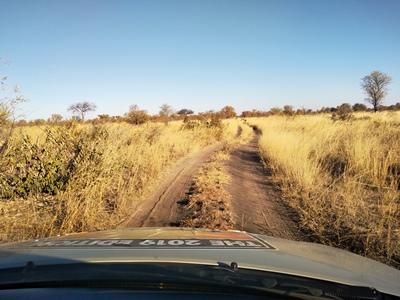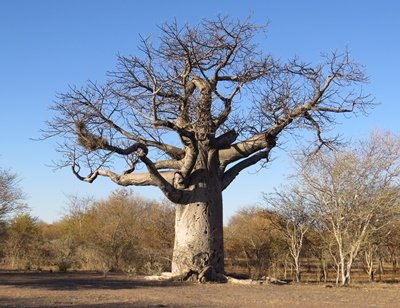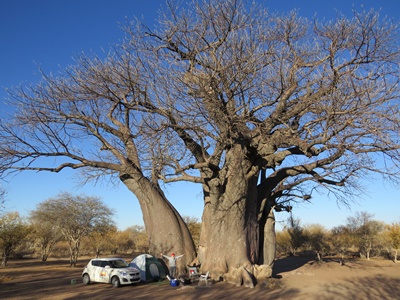
After six days on the Put Foot Rally in 2019 (see our travelogue), my wife and I were on a seemingly endless gravel road in north-eastern Namibia. We had passed through the small desert village of Tsumkwe and were heading for the Botswana border post at Dobe. It was late afternoon and we knew we wouldn't get through the border before nightfall. We had a fairly decent map, but we were in such a remote area that the details on it were pretty sketchy. Google Maps on our phones had no detail at all and showed absolutely nothing around us except the road we were on, simply marked as an "Unknown road".
Some friends of ours had told us about a truly gigantic baobab tree quite near the road, about 30 kilometres east of Tsumkwe in the Nyae Nyae Conservancy. Our plan was to go to this big tree and camp there for the night, but would we be able to find it? It was marked on our map just south of the road with a red asterisk (meaning "sight worth visiting"), but how to get there wasn't clear at all - a track was marked, but according to the map's classification it was even more of an off-road route than the road we were driving on, and that was fairly bad. We also knew from past experience that for gravel roads in remote areas such as this, the map's resemblance to reality was vague at best.

We drove east out of Tsumkwe with no real plan other than to examine every turn-off to the right and hope that there would be a road of some sort to the big tree and that it would have a sign post. Our friends had been to the big tree a year before, so it had to be possible to get there. After 30 kilometres of staring closely at the semi-desert scrub next to the road and seeing absolutely nothing except sun-blasted sand and thorn bushes we began to get despondent. Then Karen, who was driving, slowed suddenly and pointed to the LEFT of the road, where there was a decrepit, sun-faded wooden sign marked "Makuri Camp". Although the sign was on the left of the road it had an arrow pointing to the right. We stopped and looked; there was indeed a very rough trail snaking southwards, barely the width of a car and mostly soft sand. Was this the way? We'd seen nothing else. And if we went down this road would we be able to make it in our small, low-powered car? We did not have 4-wheel drive, and if we got stuck in this impossibly remote area it might be days before anybody came along. We did not have Namibian SIM cards in our cell phones, and in any case there was almost certainly no signal here, so we would not be able to call anybody. It was at least 30 kilometres to the nearest settlement (Tsumkwe) and it was already late afternoon.
For several minutes we looked down the dirt track, consulted the map and discussed what to do. But finally we decided to go for it - we were probably never going to come anywhere near here again, so why not take a chance? Karen turned onto the road and instantly the car squirmed as the wheels bit into soft sand. But she kept the engine in low gear, the revolutions up and we didn't get stuck. Occasional bushes scraped the side of the car and we slipped and skidded through particularly soft sections, but we kept going. We had no idea how far it was to the "Makuri Camp" on the sign; Google maps was no help, but it did at least recognize the road we were on - rather than "Unknown Road" it was labelled the "Baobab Trail". So that gave us some hope that we were heading in the right direction.

The sand track went on and on with no sign of baobab trees at all. We pressed on, then came to a section where the road was completely blocked by a tree that had fallen. Luckily the surface was quite hard so we could stop without worrying about getting stuck. We got out of the car for a closer look; fortunately the blockage wasn't the main trunk of the tree (if it had been we would not have been able to move it), but a branch that had split off, so we managed to shift it out of the way and continue. But still there was no sign of baobabs, and the kilometres rolled by beneath our wheels.
Eventually we came to an open area and some distance away on the left hand side we saw a huge, magnificent baobab tree. Almost simultaneously a man appeared out of the bush on the right hand side of the track. He was dressed in Western clothes (jeans and t-shirt) but looked like a Khoi San tribesman. We weren't sure if we'd be able to communicate but he spoke good Afrikaans (better than ours, in fact) and we asked him about the Big Tree. He said that the tree nearby, although a splendid speciman, wasn't THE big tree - the real Big Tree was further down the road. He pointed in the direction we were going and said it wasn't far.
Reassured, we climbed back into the car and continued down the road. We drove on for several more kilometres, carefully looking out on both sides but saw no big trees of any kind. Then suddenly the track came to an end at a junction with a proper road (still gravel, but all roads in this area, major and minor, are gravel). We stopped in confusion. The guy had said the big tree wasn't far, but we had seen nothing and now we appeared to have reached the end of the Baobab Trail. How could we have missed the tree? Or did we still have to go further? If so, which way?
It wasn't clear, but the road we'd come to was wide and straight and was either the main road from Tsumkwe to the Botswana border at Dobe or an access route to this road. Google Maps didn't help but at least our compasses told us that the way out was to the left (north). But we weren't likely to find the Big Tree going that way, so we turned round and headed back on the sandy track. By now the sun was setting and we were in despair - were we ever going to find this wretched tree? At this rate it would be dark soon and we'd have to put up our tent in some random clearing.

After about a kilometre we came across the man we'd seen earlier, together with another chap. They were walking down the road towards us and beckoned us forward, then pointed down a faint trail that veered away from the road through a clump of thorn bushes. Next to this trail we saw a sign lying on the ground that said "Makuri Camp", half covered with sand. No wonder we hadn't found the "road" to the big tree; it was so obscure that it was almost impossible to spot, and the sign pointing the way had been knocked down or had fallen over. I turned onto the track and saw in the rear view mirror that the two guys were following us. I noticed also that they made no attempt to put the sign back up again, but left it lying in the sand. Odd - without that sign I would say that it is virtually impossible to find the big tree. Maybe they didn't want people to go there? But if so why did they point the way? They could easily just not have helped us. It didn't make sense to me.
We followed very faint wheel tracks through the sand for a few hundred metres, twisting and turning through scrubby bushes, rounded a corner and stopped in gob-smacked amazement. Straight ahead of us was the most gigantic tree I'd ever seen, a giant baobab with one main trunk and several smaller ones. It was simply enormous and was standing by itself in a sandy clearing. We'd finally found THE Big Tree ... surely there could not be another tree bigger than this.
I drove slowly up to the tree, stopped and we got out for a closer look. The trunk dwarfed us, the car and everything around it. The branches spread out over the whole clearing and there were huge roots jutting out that were big enough to sit on. We walked round the tree in awe ... but the sun was setting so we looked for the best place to pitch our tent and started unpacking the car. While we were busy the two guys who'd showed us the the way arrived. The original one we'd seen had a book and said he was the custodian of Makuri Camp. He pointed to a wooden enclosure some distance away and said that it was a shower and toilet. I was incredulous - where did the water come from in this dry desert landscape? The guy laughed. "No, it is a bucket shower. You must provide the water." The toilet was an environmentally-friendly composting toilet that did not need water.

The chap said it was 70 Namibian Dollars per person to camp here, which was very little. "I also take South African Rands" he said [Aside : The Namibian Dollar is pegged at 1-1 with the SA Rand]. I gave him 140 Rands, he wrote our details in his book and gave us a receipt. He asked if we wanted wood for a fire and seemed pleased when we told him that we'd only be using gas - wood is precious in these parts and he probably appreciated that we weren't going to waste any. He bade us a good night and he and his companion disappeared into the dusk; we hadn't seen any sign of it, but we surmised that there was a village nearby. Then we unpacked the rest of our gear and set up the tent before it became completely dark. And dark it was, a total and complete absence of any light whatsoever in any direction; there was not even the faintest glow over the horizon that you usually get when there is a town some distance away. We were as far removed from any form of "civilization" as I'd ever been in my life.
There may not have been any light from earthly sources, but the sky was another matter entirely. It was cloudless, and the stars shone with a brilliance that was staggering. The band of the Milky Way was a filmy sheen of white across the entire sky and the constellations were unrecognizable amongst the myriad stars that are normally too dim to be seen. The Greater and Lesser Magellanic clouds, two small galaxies near the Milky Way, were easy to spot; neither of them is normally visible from any location near a big town or city. What an amazing sight.
The most incredible thing about it was that we had the entire camp to ourselves! No drunken louts guzzling beer, shouting and vomiting, no macho idiots standing round their braai fires talking about rugby and no camp sites lit up like a Christmas tree - it was just us and the silence of the desert. What a pleasure.
We may have been in the desert, but it was winter and the temperature dropped sharply once the sun had set. So I lit the gas stove and we threw together a quick meal from our meagre supplies. We didn't have enough water for the shower (we only had enough for drinking and cooking) so I boiled a little on the stove and we had a quick "bucket wash" out in the open - not very different from what we did in Nepal when we walked the Annapurna Circuit and stayed in high altitude villages in the Himalayas where there wasn't any hot water (see my Nepal 2016 travelogue). Then we climbed into our sleeping bags and enjoyed a blissful night of pure and complete silence.
The next morning we lingered over breakfast and coffee, enjoying the magnificence and serenity of the surroundings. But we had to be in Maun in Botswana that night, so we packed up and drove away, with one last look at the most awe-inspiring tree and camp site I've ever seen.
Rather than head back on the Baobab Trail the way we'd come in, we drove out to the access road we'd found the previous evening. At the T-junction we turned left (north) and after several kilometres arrived back at the main east-west road from Tsumkwe to the Botswana border. Twenty minutes later we reached the isolated settlement of Dobe and crossed into Botswana ... if you want to read the rest of the story of our journey through Botswana, Zambia, Malawi, Mozambique and South Africa, go to my Southern Africa 2019 travelogue.
 © Paul Kilfoil, Cape Town, South Africa
© Paul Kilfoil, Cape Town, South Africa